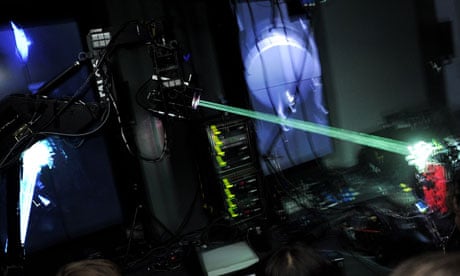I spent some of yesterday on the set of a pop video. That was what it felt like anyway. Chris Cunningham, the artist whose film Flex was a hit at the Royal Academy exhibition Apocalypse back in 2000, has a live installation at the new Audi City digital showroom on Piccadilly in central London. The private view turned out to be a launch event for this upmarket car shop where customers can choose and customise their Audi digitally – there are no cars, just terminals and screens. For the next few days, the installation can be seen there by those lucky enough to win tickets.
A car showroom without cars, where people imagine their ideal car? There might be something pornographic about that – a virtual automotive fantasy to amuse the science fiction writer JG Ballard.
To launch this cybershop, there was an art event without art. Well, that is probably a bit cruel. But something seemed to be missing, and afterwards I was told that the artist was unsatisfied with the technical performance of his array of moving, flashing, beeping stuff. There were said to be technical problems. I was promised a video of a later performance that was expected to go better, but that has not yet turned up.
So this is what I saw. The showroom goes dark. Dry ice rises in the glow of a screen's ambiguous image. Then two robots, like the robots that work on car production lines, begin a dance of courtship to the pulse of electronic music. Lasers whirl, picking out audience members, flashing on the robots' black armatures. There's an abstract image on screen. The event goes on like this for a while, until it stops.
It felt like the prelude to something. The robots would make marvellous backing dancers for Lady Gaga. It was like the filming of a pop video at which the star failed to turn up – and Cunningham has made videos for Aphex Twin and Björk.
I feel bad reviewing it because I believe the science involved is so sophisticated that it's quite possible something went wrong. But is the real problem censorship? The robots were dancing in courtship yet their ritual stopped before they touched one another. I can imagine this going on a lot longer and becoming a lot steamier, with some, er, bumping and grinding. That would be more in the spirit of Cunningham's previous work.
Would a full-on Cunningham technoromp have been too much for Audi?
A hundred years ago, Marcel Duchamp was on the verge of imagining a robotic future of machines in love. These robots seemed like Duchamp's bachelor machines, unable to get beyond a bit of whirring and whizzing. Perhaps that is not a mistake but, like Duchamp's Large Glass whose bachelors never reach their bride, a profound vision of the future.

Comments (…)
Sign in or create your Guardian account to join the discussion